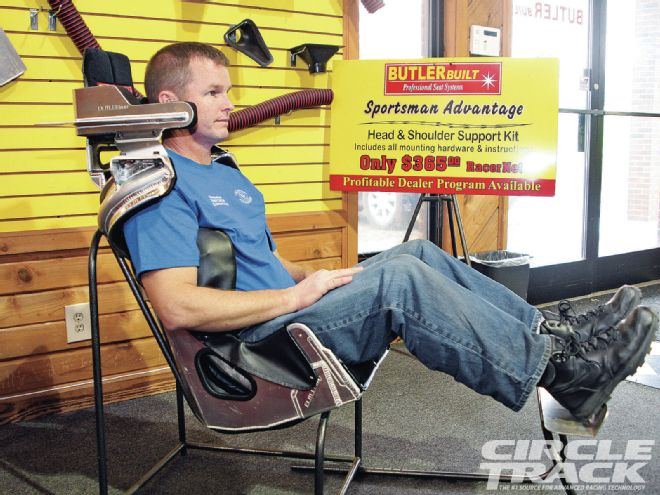
"I believe that as many as 90 percent of the injuries in racing are preventable."
That's Brian Butler, the owner of ButlerBuilt Professional Seat Systems, talking, and he should know. Butler has been at the forefront of almost all of NASCAR's safety initiatives since Dale Earnhardt's tragic death. He has also done extensive research into the types of injuries that happen at short tracks across the country. This includes the way both the tracks and cars are constructed, the safety equipment used, the average skill of the drivers, and the speeds reached.
And the answer, unequivocally, is that injuries can--and should--be decreased dramatically.
"When I go to tracks or work with racing teams, it's surprising how often you can find an issue, either with the seat or how it's mounted or something else completely," he says. "There's no argument that any person that gets into the driver seat is completely responsible for ensuring his own safety, but I also take issue with the racetracks.
"At most Saturday night tracks the only tech is to see how big the carburetor is or how much the car weighs after it pulls off the track," he continues. "Too few racetracks do an honest tech for safety, and that's a shame. Because when tech is non-existent, the racer is led to believe that everything is OK.
"You don't have to check every single car every single week, but it doesn't take too many resources to check one or two cars every week. Let the racers know what you are looking at and what's important. That way tracks can lead the way in making sure that when one of their guys gets in a wreck, they are doing everything possible to make sure he or she walks away from it without a serious injury."
A campaign to improve the safety tech programs at racetracks across the country is a bigger project than can be accomplished in just a single article, but we did want to share this just to get you thinking. We'll be sharing from Butler in the future about how to make sure your own racing program as safe as possible, but right now we'll be concentrating on the main piece of equipment that connects you directly to your race car--your racing seat.
A good quality, aluminum racing seat is not only a major component in the overall safety system, but it's also very important in terms of your results on the racetrack. A racing seat should be properly sized and mounted in the car so that it maintains your body position so that you aren't sliding around and have to exert energy and focus on holding yourself in the right spot; it's mounted so that you have good sight lines and are within easy reach so that you have good leverage on the steering wheel, the shifter, and the pedals; and it provides a good connection to the car so that you get that "seat of the pants" feel to help you know what the car is doing.
These three considerations, along with the important fact that a properly fitting seat will do a better job of protecting your body in the event of a crash, is why it's worthwhile to take the time and make sure the seat you mount in your race car is the right match for your body type. Most reputable seat manufacturers will have a variety of seat sizes that they stock to fit different body types, but if you can't provide them the proper measurements there is no way for them to know which seat will fit you the best. And even then, an off-the-shelf seat doesn't guarantee that it will be the best fit for you. Sometimes, the best option is to invest in a custom-built seat both for your safety and your ability to concentrate on racing without distractions from inside the cockpit.
Amazingly, Butler told us that he will change his seats based on the angle of recline on which it will be mounted. Over years of working with countless drivers, many in the NASCAR Sprint Cup Series as well as the top Dirt Late Model drivers, Butler says that as a general rule having the seat reclined 20 degrees from vertical provides the best opportunity to feel what the car is doing. Sometimes, depending on the style of car and the driver's height, that angle must be adjusted, but generally, Butler likes to keep the seat angle within 5 degrees in either direction (15 to 25 degrees back from vertical). The rest of the seat is built off of this angle.
We followed along as Butler fitted racer Jason Gulledge for a new seat that will go into a Super Street race car that he's building. Other manufacturers may have instructions that vary slightly, but the concept is still the same. We'll follow up later as Gulledge installs the seat in his car, but the first step is to get the seat that best fits your body. Even if you aren't anywhere near a manufacturer so that it can fit you, here's how you can have someone help you get the measurements you will need to provide.